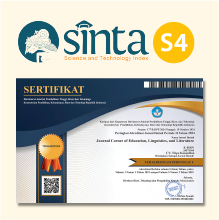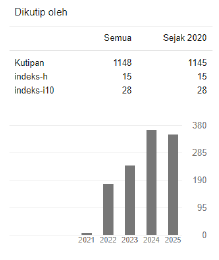Constructing Ethnolinguistic Identities: A Critical Examination of Language and Power Dynamics in Diasporic Communities
 https://doi.org/10.54012/jcell.v4i2.339
https://doi.org/10.54012/jcell.v4i2.339
 Abstract views: 366
Abstract views: 366
 PDF downloads: 325
PDF downloads: 325
Keywords:
Ethnolinguistic, Cultural Resistance, Diasporic Dynamics, IdentityAbstract
This research investigates the complex interplay between language and power in the formation of ethnolinguistic identities within diasporic communities. As globalization accelerates, diasporic groups navigate a complex landscape where traditional linguistic practices intersect with new socio-political realities. This study aims to critically examine how language functions as a tool for negotiating identity and power within these communities, emphasizing the role of language ideologies and practices in shaping social dynamics. The primary objectives are to explore how language serves as a medium for the construction and negotiation of ethnolinguistic identities and to understand the influence of power relations on these processes. Specifically, the study seeks to identify the ways in which language practices reflect and challenge power structures within diasporic contexts and how these practices contribute to the formation of collective and individual identities. This research is a multi-sited ethnographic approach,and integrates discourse analysis across several diasporic communities. Findings reveal that language serves as a strategic resource for negotiating social status and ethnic belonging. Diasporic individuals employ code-switching, language reclamation, and multilingualism to assert identity and resist assimilation pressures. The study highlights how language ideologies both reinforce and contest existing power structures, demonstrating the dynamic role of language in shaping ethnolinguistic identities amidst shifting socio-political landscapes.
Downloads
References
Ballard, R. (2009). The dynamics of translocal and transjurisdictional networks: A diasporic perspective. South Asian Diaspora, 1(2), 141–166. https://doi.org/10.1080/19438190903109487
Bauman, R. (2022). Language, identity, performance. Pragmatics. Quarterly Publication of the International Pragmatics Association (IPrA), March 2000, 1–5. https://doi.org/10.1075/prag.10.1.01bau
Block, D. (2013). Issues in language and identit research. Elia, 13(3), 11–46.
Brinkerhoff, J. M. (2012). Digital diasporas’ challenge to traditional power: The case of TibetBoard. Review of International Studies, 38(1), 77–95. https://doi.org/10.1017/S0260210510001737
Bucholtz, M. (1999). “Why be normal?”: Language and identity practices in a community of nerd girls. Language in Society, 28(2), 203–223. https://doi.org/10.1017/s0047404599002043
Demmers, J. (2002). Diaspora and conflict: Locality, long-distance nationalism, and delocalisation of conflict dynamics. Javnost, 9(1), 85–96. https://doi.org/10.1080/13183222.2002.11008795
Drzewiecka, J. A., & Halualani, R. T. (2002). The structural-cultural dialectic of diasporic politics. Communication Theory, 12(3), 340–366. https://doi.org/10.1111/j.1468-2885.2002.tb00273.x
Heller, M. (2003). Globalization, the new economy, and the commodification of language and identity. Journal of Sociolinguistics, 7(4), 473–492. https://doi.org/10.1111/j.1467-9841.2003.00238.x
Holmes, J. (1997). Women , language and identity 1. 195–223.
Mahler, S. J., & Hansing, K. (2005). Toward a transnationalism of the Middle: How transnational religious practices help bridge the divides between Cuba and Miami. Latin American Perspectives, 32(1), 121–146. https://doi.org/10.1177/0094582X04271874
Menjívar, C. (1999). Religious institutions and transnationalism: A case study of catholic and evangelical Salvadoran immigrants. International Journal of Politics, Culture and Society, 12(4), 589–612. https://doi.org/10.1023/A:1025990209941
Mensah, J. (2008). Religious transnationalism among Ghanaian immigrants in Toronto: A binary logistic regression analysis. Canadian Geographer, 52(3), 309–330. https://doi.org/10.1111/j.1541-0064.2008.00215.x
Mutambasere, T. (2022). Connecting religious transnationalism and development: charitable giving amongst Zimbabwean Catholics in London. Third World Quarterly, 43(1), 259–277. https://doi.org/10.1080/01436597.2021.2005463
Norton, B. (1997). Ownership of English. TESOL Quarterly, 31(3), 409–429.
Religion in Africa: A Very Brief Overview. (2010).
Rogers, R. (2014). in the Digital Age. International Public Policy Review, 8(1), 73–87.
Singh, G. (2013). Religious transnationalism, development and the construction of religious boundaries: The case of the Dera Sachkhand Ballan and the Ravidass Dharm. Global Networks, 13(2), 183–199. https://doi.org/10.1111/glob.12005
Tam, J. (2019). Renegotiating religious transnationalism: fractures in transnational Chinese evangelicalism. Global Networks, 19(1), 66–85. https://doi.org/10.1111/glob.12194
Tan, Y., Liu, X., & Rosser, A. (2021). Transnational linkages, power relations and the migration–development nexus: China and its diaspora. Asia Pacific Viewpoint, 62(3), 355–371. https://doi.org/10.1111/apv.12323
Unless, R., Act, P., Rose, W., If, T., & Rose, W. (2020). Migration, diaspora and transnationalism: transformations of religion and culture in a globalising age. The Routledge Companion to the Study of Religion, 538–561. https://doi.org/10.4324/9780203412695-37
Varghese, M., Morgan, B., Johnston, B., & Johnson, K. A. (2005). Theorizing Language Teacher Identity: Three Perspectives and Beyond. Journal of Language, Identity & Education, 4(1), 21–44. https://doi.org/10.1207/s15327701jlie0401_2
Version, D. (2015). Paper Language and identity in linguistic ethnography.
Downloads
Published
How to Cite
Issue
Section
License
Copyright (c) 2024 Sarwar Nuristani , Enayatullah Dadman, Sultan Mohammad Stanikzai

This work is licensed under a Creative Commons Attribution-ShareAlike 4.0 International License.
All articles published in the Journal Corner of Education, Linguistics, and Literature are licensed under the Creative Commons Attribution-ShareAlike License (CC BY-SA).

















